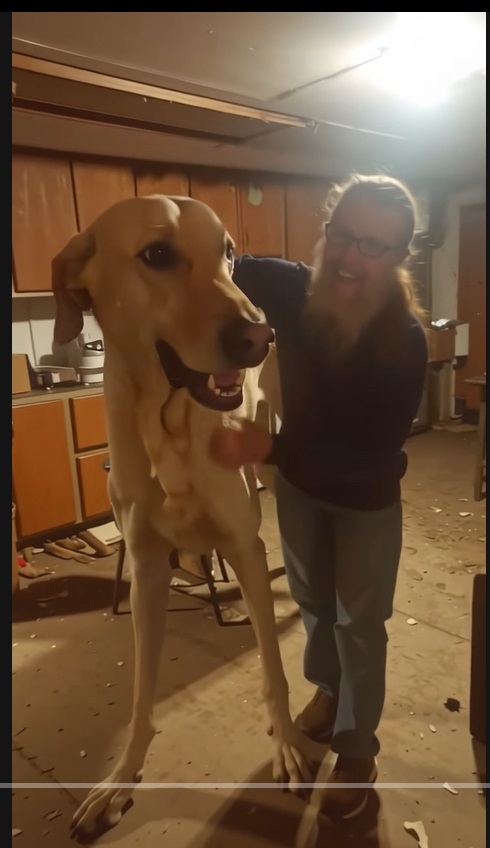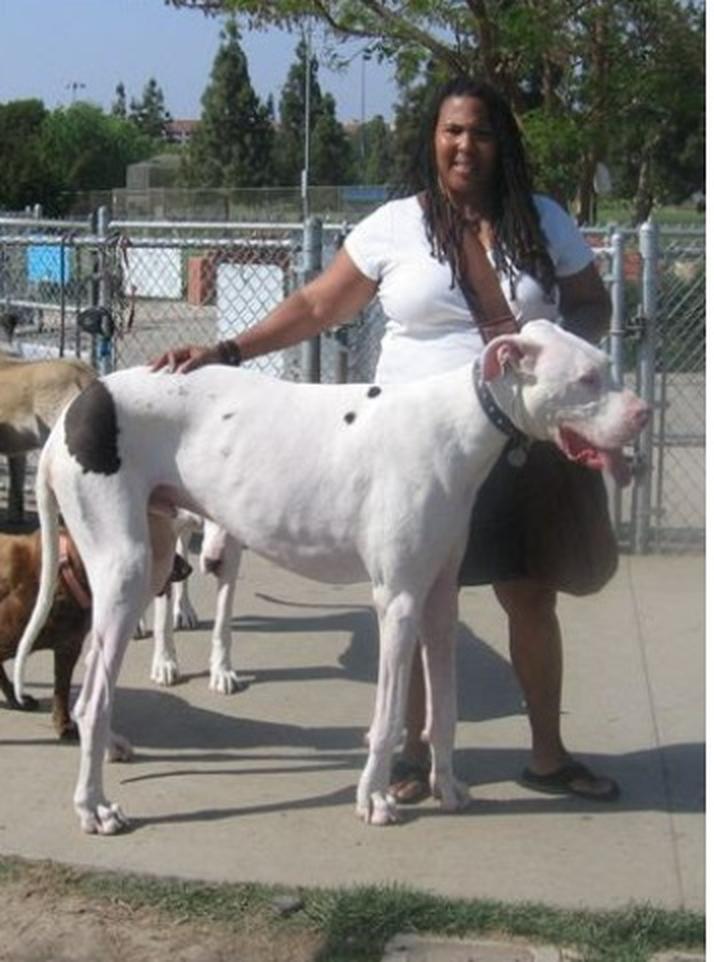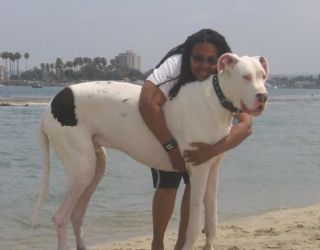The internet loves animals—especially when they come in giant, jaw-dropping sizes. So when a photo and video of a colossal canine named “Titan Dog” started going around on social media, millions stopped scrolling. Towering over cars and humans, this massive dog became an overnight sensation. But here’s the kicker: Titan Dog isn’t real. It’s the latest in a wave of AI-generated hoaxes that continue to blur the lines between reality and digital fantasy.
In this post, we’ll break down the truth behind the viral Titan Dog, explain why people believed it, explore the dangers of AI-generated content, and give you tips on how to spot synthetic media before it fools you.
What Is the “Titan Dog” and Why Did It Go Viral?
How the Viral Image Was Born
The now-famous “Titan Dog” first appeared on platforms like TikTok, X (formerly Twitter), and Instagram, with a dog of monstrous proportions in what looked like real-world settings. No context. No caption. Just shock.
Within hours, the comments exploded:
- “This can’t be real, right?”
- “I want one!”
- “Is this a dog or a horse on steroids?”
The virality fed itself. The more people questioned it, the more the algorithm pushed it. Before long, the image had been shared over a million times across platforms. People started remixing the content, making memes, adding dramatic music, and even falsely attributing it to news outlets.
Why People Believed It
It looked too real to be fake. The lighting, the shadows, the way the dog interacted with its environment—all so convincing. And that’s exactly what AI-generated visuals are designed to do.
Most people scrolling through social media don’t pause to look at images. Combine realistic visuals with no disclaimer and it’s easy to assume it’s real.
Plus, pet content is already super popular online. A giant, friendly-looking dog hits the sweet spot for virality: novelty + cuteness + shock.

Is Titan Dog Real? (Spoiler: It’s AI-Generated)
✉️ Statement from the Creator
Eventually, the creator stepped forward and admitted the image was created using AI. The purpose, they claimed, was not to deceive but to showcase the power of generative design. Yet once the image escaped its original post, context vanished—and confusion spread.
“I made it as an experiment,” the creator said. “I never thought people would think it was real.”
Unfortunately, intent doesn’t matter once an image goes viral. Without a watermark or label, synthetic content can easily be mistaken for reality. Here is the orginal Viral Titan video link
⚙️ How It Was Made
While the exact tool wasn’t confirmed, many speculate it was created using Midjourney (v6 or newer) or DALL·E 3, both capable of generating photorealistic content.
For example, with a prompt like:
“a gigantic dog standing next to a house, photorealistic, 8K lighting, hyper-detailed fur texture, scale perspective,”
the AI system will generate multiple image options. The user then selects or refines the most believable version.
Some AI art tools even allow for image “inpainting” or background consistency tweaks—further boosting realism.
⚖️ How AI Fooled the Internet—Again
Why We Keep Falling for It
Humans are wired to believe what we see. When images are sharp, realistic, and seemingly grounded in real-world physics, our brains accept them as truth—especially when context is removed.
Social media doesn’t incentivize skepticism; it rewards speed and emotion. If a post looks cool, weird, or cute, we share it—rarely asking if it’s real.
Other Animal Hoaxes Powered by AI
This isn’t the first time people have fallen for viral pet hoaxes:
- Giant cat on a roof “guarding” a city (AI)
- Owl with dragon wings seen in Alaska (AI)
- Photos of a dinosaur-dog hybrid (AI)
Each of these took the internet by storm, only to be later debunked.
⚠️ The Risks of Believing AI-Generated Content
❌ Trust Erosion and Misinformation
At first glance, the Titan Dog hoax may seem harmless. But it’s part of a larger trend that can have dangerous consequences.
- Fake AI content has been used to spread false political narratives
- Synthetic videos of celebrities saying things they never said are becoming common
- AI-generated “news” stories are being mistaken for real journalism
As AI improves, the line between truth and fiction gets thinner—and the public’s ability to tell the difference weakens.
️♂️ How to Spot an AI-Generated Image
Here are a few quick tips:
- Look closely at paws, eyes, and hands: AI often struggles with anatomical accuracy
- Check for inconsistencies in shadows and reflections
- Zoom in on the background: You’ll often find warped signs, glitchy textures, or unrealistic patterns
- Use tools like Google Lens or AI-detection platforms like Hive, Sensity.ai, or Illuminarty
The Titan Dog image, upon inspection, had telltale signs: odd paw proportions, a slight halo effect around the ears, and an oddly clean environment.

Real Giant Dogs That Actually Exist
Titan the Great Dane (2009 Guinness Record Holder)
There was a real dog named Titan, a white Great Dane from California. In 2009, he held the Guinness World Record for Tallest Dog Alive:
- Height: 42.25 inches (107.3 cm)
- Weight: ~190 lbs (86 kg)
- Health issues: deaf, partially blind, and epileptic
Despite his size, Titan was known to be a gentle giant and helped raise awareness about responsible breeding and genetic conditions in white Great Danes.

Other Real Giant Breeds
While the viral “Titan Dog” is fake, here are some of the largest real-life dog breeds:
| Breed | Height Range | Weight Range |
| Great Dane | 28–34 inches | 100–200 lbs |
| English Mastiff | 27–33 inches | 120–230 lbs |
| Irish Wolfhound | 30–35 inches | 105–180 lbs |
| Saint Bernard | 26–30 inches | 140–180 lbs |
These dogs are enormous by typical standards—but still far from the skyscraper-sized Titan of the viral image.
What This Hoax Teaches Us About the Future
We are entering a world where synthetic media is no longer a novelty—it’s the norm. As AI tools become easier to access and use, their creations will blend more seamlessly into our information ecosystem.
This hoax teaches us:
- To be more skeptical of what we see online
- That even harmless content can mislead the public
- We need platform accountability to label AI content
- Education and digital literacy must become part of how we teach media consumption
Social media users should get used to asking: “Is this real?”—even when it’s just a cute dog photo.
♂️ FAQ: Titan Dog Viral Hoax
Q1: Is the Titan Dog real?
A: No. It was created using AI tools and is not based on a real animal.
Q2: Why did people believe it was real?
A: The image was highly realistic and lacked clear context. Many users assumed it was a photo.
Q3: What tool was used to create it?
A: Likely Midjourney or DALL·E, though not confirmed.
Q4: Are there dogs nearly that big in real life?
A: No. Even the tallest Great Danes don’t come close to the size shown in the AI image.
Q5: How can I tell if an image is AI-generated?
A: Look for distorted anatomy, mismatched shadows, or use reverse image search tools.
Q6: Why should we care about hoaxes like this?
A: While some are harmless, AI hoaxes can lead to misinformation, erode trust in media, and even be used maliciously.
✅ Conclusion
“Titan Dog” might be a viral AI illusion, but it opened real conversations about trust, digital literacy, and our growing dependency on social media for “truth.” Next time you see something unbelievable? Take a breath, do a little digging, and remember: Not everything that goes viral is real.
The next viral image could be political, financial, or medical—and that’s where the real danger lies. Titan was cute. The next one might not be.


